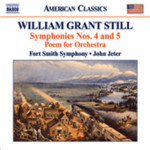
Still: Symphony No 4 "Autochthonous" / Symphony No 5 "Western Hemisphere"
 $25.00
Out of Stock
$25.00
Out of Stock6+ weeks add to cart
WILLIAM GRANT STILL
Still: Symphony No 4 "Autochthonous" / Symphony No 5 "Western Hemisphere"
Fort Smith Symphony, John Jeter, conductor
[ Naxos American Classics / CD ]
Release Date: Tuesday 1 December 2009
This item is currently out of stock. It may take 6 or more weeks to obtain from when you place your order as this is a specialist product.
"Revel in these fine and likeably accessible works."
(MusicWeb Nov 2009)
"William Grant Still was nothing if not a practical musician. Long before he aspired to symphonies he had seen service as an editor for W.C. Handy (composer of St Louis Blues) and Artie Shaw (whose Frenesi he orchestrated), an arranger for jazz groups and a pit orchestra musician able to turn his hand to any immediate task. His folk-inflected Symphony No. 1 'Afro-American' dates from his time (1930s) in Los Angeles arranging for Paul Whiteman and moving into film and radio music.
His Fourth Symphony with its loquacious and seemingly easy way with popular culture influences including spirituals, blues, jazz, shows and Western film manners is superbly fluent - the mix unassailably resolved with no awkwardness or seams. It's music of 1940s smiling confidence-chromium yet yielding and flowing with a guileless Dvořákian pleasure from the pioneer's limitless horizons to Ravelian introspection. This is very pleasing music with ideas couched in touching terms-as in the epic, deeply touching and wondering-wandering 'chorale' theme in the finale of the Fourth. The Fourth was given its first performance under Victor Alessandro and the Oklahoma City Symphony Orchestra on 18 March 1951.
The four movement Fifth Symphony has a convoluted history but its premiere was given by the Oberlin College Orchestra under Robert Baustian on 9 November 1970. It's a compact work with the movements dovetailing most naturally. Those with a predilection for folk romantic writing will find this work irresistible. Moments here and there are reminiscent of Hanson, Harris and Gershwin but nothing to suggest a tired imaginative resource-quite the contrary. It has the lovely flowing innocence of the Fourth yet is not without creative tension.
The Poem for Orchestra was a commission from the Kulas American Composers' Fund for the Cleveland Orchestra. Erich Leinsdorf was behind the idea. It was premiered by the Cleveland Symphony conducted by Rudolph Ringwall on 7 and 9 December 1944. A wartime work, it has an almost Baxian tense quality heard especially in the flurrying woodwind. This is moderated by one of Still's slippery and superbly rounded motifs. Finally there's a gleaming Delian deliquescence (6:40) with just a suggestion of a sentimental tear. The Poem is well worth programming first to catch something of the essence of the orchestral Still.
David Ciucevich Jr., in his notes, points to Still's many firsts as an African-American: first symphony performed by a major symphony orchestra (1935, New York Philharmonic, Afro-American); first to conduct a major orchestra (1936, Los Angeles Philharmonic); "first to conduct an orchestra in the Deep South (1955, New Orleans Philharmonic); first to have an opera produced by a major company (1949, Troubled Island, New York City Opera), and first to have an opera broadcast on television (posthumously in 1981, A Bayou Legend, PBS)."
This fascinating recording was part-facilitated by a grant from the Department of Arkansas Heritage and the Fort Smith Convention and Visitor's Bureau. Let's now hear the symphonies 2 and 3.
I do hope that Naxos American Classics will pick up Arthur Farwell's Rudolph Gott symphony and Piano Quintet (both epic works), Roy Harris's symphonies 10-14, Edward Burlinghame Hill's concertos and Frederick Converse's symphonies. Meantime revel in these fine and likeably accessible works."
(MusicWeb Nov 2009)
Tracks:
Symphony No. 5, "Western Hemisphere"
Poem
Symphony No. 4, "Autochthonous"